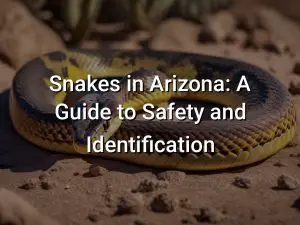Types of Scorpions in Arizona: A Guide (2023)

Arizona, known for its vast desert landscapes, is home to a fascinating array of scorpion species. These arachnids have adapted to thrive in the harsh desert environment and are known for their unique characteristics and venomous stings. In this guide, we will take a closer look at the different types of scorpions found in Arizona, including the notorious Arizona Bark Scorpion and the imposing Giant Hairy Scorpion.
From the distinctive markings of the Striped Tail Scorpion to the intimidating size of the Arizona Giant Desert Hairy Scorpion, each species has its own set of traits and behaviors. Whether you’re an Arizona local or planning a visit to the desert, understanding the various types of scorpions in the area can enhance your knowledge of the local ecosystem and ensure your safety. Join us as we explore the diverse world of scorpions in Arizona.
Quick Links
Arizona Bark Scorpion
The Arizona Bark Scorpion is one of the most common and venomous scorpions found in Arizona. It is known for its light brown color and slender body, which can range from 2.75 to 3.25 inches in length. The Arizona Bark Scorpion is nocturnal and prefers to hide in cool, dark areas during the day.
The venom of the Arizona Bark Scorpion is potent and can cause severe pain, numbness, and tingling in the area of the sting. In some cases, individuals may also experience muscle spasms, difficulty breathing, and increased heart rate. While rarely fatal, a sting from an Arizona Bark Scorpion should be taken seriously, especially for children, the elderly, and individuals with compromised immune systems.
To prevent encounters with Arizona Bark Scorpions, it is important to take precautions such as shaking out shoes and clothing before putting them on, sealing cracks and crevices in homes, and removing potential hiding places around the property, such as woodpiles and debris. If a scorpion is found indoors, it should be captured and removed using appropriate safety measures or by contacting a professional pest control service.
Overall, while the Arizona Bark Scorpion can pose a threat to humans, awareness and preventive measures can greatly reduce the risk of encounters and stings.
Giant Hairy Scorpion
The Giant Hairy Scorpion (Hadrurus arizonensis) is one of the largest scorpions found in Arizona. It is known for its intimidating size and distinct appearance. The body of the Giant Hairy Scorpion can reach up to six inches in length, making it quite a sight to behold.
Although its name suggests otherwise, the Giant Hairy Scorpion is not as dangerous as some other scorpion species. Its venom is not considered lethal to humans, although it can cause painful stings. People often describe the sensation as similar to a bee sting.
The Giant Hairy Scorpion is nocturnal, preferring to stay hidden during the day and hunting for prey at night. It feeds on insects, spiders, and sometimes even small lizards. In the wild, it typically makes its home in desert areas with sandy soil and rocks, using burrows or other sheltered spots.
Fortunately, encounters with the Giant Hairy Scorpion are relatively rare due to its reclusive nature. However, if you do come across one, it is important to exercise caution and avoid provoking or handling it. If stung, it is recommended to seek medical attention for pain management and to ensure no adverse reactions occur.
Overall, the Giant Hairy Scorpion is a fascinating creature that plays an important role in the Arizona desert ecosystem. Its unique appearance and interesting behaviors make it an intriguing species to study and admire from a safe distance.
Striped Tail Scorpion
The Striped Tail Scorpion is one of the many species of scorpions found in Arizona. Also known as the Devil Scorpion, it is typically smaller in size compared to other scorpions in the region.
The Striped Tail Scorpion gets its name from the distinctive black stripes on its tail, which serve as a warning to potential predators. These stripes are a characteristic feature of the species and help distinguish it from other types of scorpions.
Like other scorpions, the Striped Tail Scorpion has a venomous sting, but it is not considered dangerous to humans. Its venom is relatively mild and typically only causes localized pain and discomfort. However, individuals with allergies or who are sensitive to scorpion venom may experience stronger reactions.
The Striped Tail Scorpion is predominantly nocturnal and spends its days hiding in burrows or under rocks to escape from the heat. It emerges at night to hunt for insects and other small prey.
When disturbed or threatened, the Striped Tail Scorpion may raise its tail and curl its body, displaying its stinger as a warning signal. It prefers to avoid confrontation and will usually only sting if it feels threatened or cornered.
Although the Striped Tail Scorpion can be found in various habitats throughout Arizona, it is most commonly found in desert and arid regions. It plays an important role in the ecosystem by controlling insect populations.
If you come across a Striped Tail Scorpion in Arizona, it is best to observe it from a safe distance and avoid provoking or handling it. If you are stung by a scorpion, it is important to seek medical attention if you experience severe symptoms or have an allergic reaction.
Arizona Giant Desert Hairy Scorpion
The Arizona Giant Desert Hairy Scorpion, also known as Hadrurus arizonensis, is one of the largest scorpions found in the United States and is native to the Sonoran Desert in Arizona. It is known for its intimidating size, measuring up to 6 inches in length.
This species of scorpion has a distinct appearance with a dark brown or black body and a hairy exoskeleton. The hairs on its body help it to detect vibrations and navigate its environment. Despite its intimidating appearance, the Arizona Giant Desert Hairy Scorpion is not considered highly venomous and is generally not a threat to humans, unless the individual has an allergic reaction to the venom.
The habitat of the Arizona Giant Desert Hairy Scorpion includes desert areas with sandy soil and rocky outcrops. It is primarily nocturnal, seeking shelter during the day and becoming active at night to hunt for prey, which mainly consists of insects. This scorpion is an ambush predator, using its powerful pincers to catch and immobilize its prey before injecting it with venom.
When threatened, the Arizona Giant Desert Hairy Scorpion may use its venomous stinger as a defense mechanism. It will raise its tail and use the stinger to deliver venom to deter potential predators. However, it is important to note that the venom of this scorpion is generally not life-threatening to humans.
Although encounters with the Arizona Giant Desert Hairy Scorpion are relatively rare, it is essential for individuals to exercise caution when exploring its natural habitat. It is advisable to wear protective clothing and footwear when venturing into areas where scorpions may be present, especially at night when they are most active.
Stripe-Tailed Scorpion
The Stripe-Tailed Scorpion is one of the many scorpion species found in Arizona. Also known as Vaejovis spinigerus, it is a medium-sized scorpion with a yellowish-brown color and distinctive stripes on its tail.
The Stripe-Tailed Scorpion is commonly found in desert habitats across Arizona, including rocky areas, sand dunes, and desert grasslands. It is a nocturnal creature and prefers to stay hidden during the day, emerging at night to hunt for food.
Like other scorpions, the Stripe-Tailed Scorpion has a pair of large pincers in the front and a long, slender tail with a venomous stinger at the end. Its venom is not considered life-threatening to humans, although it can cause pain and discomfort.
These scorpions primarily feed on small insects, spiders, and other arthropods. They use their pincers to catch and immobilize their prey before injecting venom to subdue it.
If you come across a Stripe-Tailed Scorpion in Arizona, it is best to observe it from a distance and avoid any unnecessary interactions. While their venom is not highly dangerous, it can still cause pain and irritation if you are stung.
As with all scorpions, it is important to take proper precautions when exploring areas where scorpions are known to reside. This includes wearing protective clothing, such as gloves and closed-toe shoes, and being mindful of your surroundings.
If you are stung by a Stripe-Tailed Scorpion or any other scorpion in Arizona, it is recommended to seek medical attention if you experience severe pain, allergic reactions, or other concerning symptoms.
Overall, the Stripe-Tailed Scorpion is just one of the many fascinating scorpion species found in Arizona’s diverse desert ecosystems. Learning about these creatures can help us better appreciate the unique wildlife that inhabits this region.
Yellow Ground Scorpion
The Yellow Ground Scorpion, also known as Vaejovis confusus, is a species of scorpion commonly found in Arizona. It is named after its distinctive yellow coloration and is one of the smaller scorpion species in the region, typically measuring around 2-3 inches in length.
Despite its small size, the Yellow Ground Scorpion can deliver a painful sting if provoked. Its venom is not considered life-threatening to humans, but it can cause localized pain, swelling, and redness. It is important to exercise caution when encountering this species and to avoid handling or provoking them.
The Yellow Ground Scorpion is a nocturnal creature, primarily active at night. During the day, it seeks shelter in burrows or under rocks and logs. It feeds primarily on insects, spiders, and other small invertebrates.
This species is typically found in desert and semi-arid regions, particularly in rocky or sandy areas. It is commonly encountered in residential areas, where it may seek refuge in sheds, garages, or other outdoor structures.
If you come across a Yellow Ground Scorpion, it is best to leave it undisturbed and avoid reaching into areas where it may be hiding. If you suspect an infestation or have concerns about scorpion presence in your home, it is recommended to contact a professional pest control service for assistance.
Remember, scorpions play an important role in the ecosystem and are a natural part of the Arizona desert. It is important to respect their habitats and exercise caution when in their presence.
Black Scorpion
The black scorpion is a species of scorpion native to Arizona. It gets its name from its dark black coloration, which helps it blend in with its surroundings. Black scorpions are known for their venomous stings, although they are not usually aggressive towards humans unless provoked.
Black scorpions can be found in various habitats throughout Arizona, including desert areas and rocky terrain. They are nocturnal creatures, preferring to stay hidden during the day and coming out to hunt for prey at night.
These scorpions feed on a diet of insects, spiders, and other small arthropods. They use their strong pincers to grasp and capture their prey before delivering a venomous sting to immobilize it.
When it comes to reproduction, black scorpions engage in a unique courtship dance. The male scorpion performs a series of movements and vibrations to attract the female, and if successful, they will mate. The female then carries the young scorpions on her back until they are ready to venture out on their own.
If you encounter a black scorpion in Arizona, it is best to observe it from a safe distance and avoid provoking it. If stung, seek medical attention as soon as possible, as some individuals may have allergic reactions to the venom.
Northern Scorpion
The Northern Scorpion (Paruroctonus boreus) is a species of scorpion commonly found in the Northern regions of Arizona. They are medium-sized scorpions, typically measuring around 2 to 3 inches in length.
The Northern Scorpion is dark brown or black in color, with two large pedipalps (pincers) at the front of their body. They have a slender tail with a stinger at the end, which they use to defend themselves or capture prey.
Despite their intimidating appearance, Northern Scorpions are generally not aggressive towards humans and only sting when threatened. Their venom is considered mild and rarely poses a significant health risk to humans, although individuals may experience pain, swelling, and redness at the site of the sting.
These scorpions are nocturnal hunters, venturing out of their burrows at night to search for prey, which primarily consists of insects, spiders, and other small arthropods. They are skilled predators, using their pincers to capture and subdue their prey before delivering a venomous sting.
Northern Scorpions are most commonly found in rocky desert areas, such as canyons, mountains, and grasslands. They prefer to burrow in sandy soil or under rocks during the day to escape the heat, emerging at night to hunt and feed.
If you encounter a Northern Scorpion in Arizona, it is best to observe them from a safe distance and avoid provoking or handling them. In the event of a sting, it is recommended to clean the area with mild soap and water, apply a cold compress to reduce swelling, and seek medical attention if necessary.
Whip Scorpion
The whip scorpion, also known as the vinegaroon, is a unique and fascinating arachnid found in Arizona. Despite its name, the whip scorpion is not a true scorpion and is actually more closely related to spiders and ticks.
Whip scorpions are known for their distinctive appearance, with a long, whip-like tail known as a flagellum. This tail is used for a variety of purposes, including sensing their environment and defending themselves against predators.
Unlike true scorpions, whip scorpions do not have a stinger and are not venomous. Instead, they have a pair of large pincers at the front of their body that they use to catch and subdue their prey. Whip scorpions are nocturnal hunters and feed on a diet of insects and other small invertebrates.
One unique behavior of whip scorpions is their ability to release a defensive spray of acetic acid, which gives them their common name “vinegaroon.” This spray is used to deter predators and can be quite potent, causing a strong vinegar-like smell.
Whip scorpions are generally shy and non-aggressive toward humans, and they are rarely encountered indoors. However, if you do come across a whip scorpion, it is best to observe it from a distance and avoid handling it, as they can still deliver a pinch with their pincers.
Overall, whip scorpions are fascinating creatures that play an important role in the ecosystems of Arizona. Their unique appearance and behaviors make them a fascinating subject of study for arachnid enthusiasts and researchers.
Desert Striped Scorpion
The Desert Striped Scorpion, also known as the Arizona Brown Scorpion, is a common species found in Arizona. It is a medium-sized scorpion, growing up to 3 inches in length. The Desert Striped Scorpion gets its name from the distinct stripes that run along its body.
These scorpions are nocturnal creatures, spending their days hiding in burrows or under rocks and emerging at night to hunt for food. They are carnivorous and feed on insects, spiders, and other small arthropods.
The sting of a Desert Striped Scorpion is painful but usually not life-threatening, unless you are allergic. If stung, you may experience localized pain, swelling, and redness. It is important to seek medical attention if you have any severe symptoms or an allergic reaction.
As with all scorpions, it is best to avoid handling or provoking these creatures. If you encounter a Desert Striped Scorpion, it is recommended to give it space and observe from a safe distance.
In Arizona, the Desert Striped Scorpion is a common sight and is often seen in desert habitats, including rocky areas, sandy soils, and even urban areas. While they may be intimidating, these scorpions play an important role in the ecosystem as predators of other small insects and arachnids.
It is important to be cautious and aware of your surroundings when exploring areas where scorpions are known to inhabit. Taking precautions such as wearing closed-toe shoes, shaking out clothing and shoes before putting them on, and using a flashlight at night can help reduce the risk of a scorpion encounter.
Conclusion
Arizona is home to a variety of scorpion species, each with its own characteristics and behaviors. It is important to familiarize yourself with the different types of scorpions in the region to understand how to identify and handle encounters with them.
Remember to exercise caution when encountering scorpions, as some species have venomous stings that can cause discomfort or health issues. If you find scorpions in your home or suspect an infestation, it is recommended to seek professional assistance to ensure safe removal and prevention methods are implemented.






